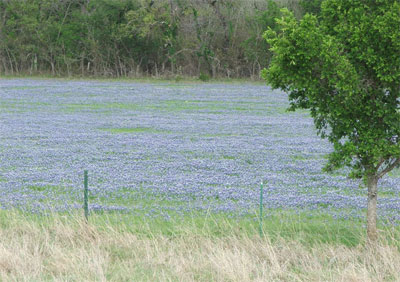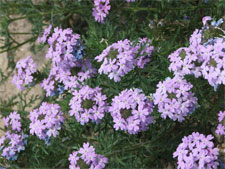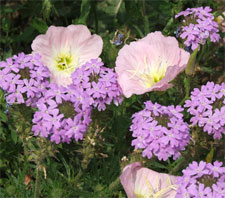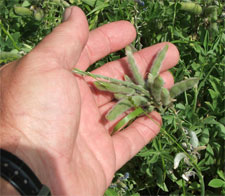Native Son – April, 2009

Texas bluebonnets, south of Blanket Creek.
Photos by Steven Chamblee.
Road Trip to Brownwood

Prairie verbena.
Slid into the driver’s seat and headed out for the ride to Brownwood, a nice little town about 100 miles south of Weatherford. Accidentally drove right by good ol’ Tin Top Road, where a whiff of baby powder scent hit my nose, so I went to check it out. There it was, 90 feet south of I-20, along the access road … a veritable sea of verbena. Thousands of plants in full bloom, sprinkled with a little slender vervain and some splashes of pink evening primrose. And the most amazing part was that about two years ago, a bulldozer had wiped this 40-acre parcel clean during an “improvement project.” Like Malcolm said in Jurassic Park, “Nature finds a way.” Reminds me that while change is inevitable, it is often reversible. World-famous Butchart Gardens was once a quarry, as was the Japanese Garden in Fort Worth .

Pink evening primrose
and prairie verbena.
Prairie verbena has also gone through its change … well, not the plant — just the botanical name — from Verbena bipinnatifida to Glandularia bipinnatifida. I remember being somewhat perturbed by this “necessary name change,” in the same sort of way I was annoyed by that “improvement project.” Man, can’t we just leave some things alone? Truth is, probably not. And it’s not all bad.… I’m listening to my Maná En Vivo CD while writing this on my laptop after reviewing the digital photos while talking on my cell phone. (Don’t worry, Dad, I still change my own oil.) And after a few years of mellowing, I realized that name change actually was necessary… as well as those changes my father said I should create in myself.
Prairie verbena is a survivor because of its ability to adapt to change. Interestingly enough, the BRIT book doesn’t even mention its place in the native prairies, opting instead to say that it is found in “disturbed areas.” In pre-bulldozer days, I suppose the disturbing was done by bison. Maybe they were trying to decorate themselves with the delicate clusters of flowers … or perfume themselves with that lovely scent … or perhaps the color lavender just drove them wild, inducing all that crazy wallowing.
Ummm … Brownwood. Blew into town on Hwy 377 with just seconds to spare before my talk, and ended up being late anyway (first time ever) because I got distracted with that giant barbecue sign, missed my turn, and blew right on out of town on Hwy 67. Thank goodness they are the most gracious folks around, serving up forgiveness with the same big ol’ ladle as cream gravy. My talk went well and the wildflower show was simply spectacular. Over 150 native plant species — from Alyosia to Ziziphus — all in full bloom in the same room. Crazy good! (Go mark your calendar right now for next year’s Brownwood Wildflower Festival.) I hobnobbed a bit, ate some homemade brownies, and checked out Billy Kniffen’s presentation on water conservation. He has LOTS of good ideas and illustrations about saving and using water wisely. And, boy howdy, talk about a change coming down the road like a six-axle semi loaded down with bridge parts … we Texans have got to get our act together concerning water conservation.

Immature bluebonnet seeds. Make sure your seeds have matured and the capsules have dried before mowing.
Almost wrecked the truck just south of Blanket Creek … a quilt of bluebonnets smothering about 20 acres was almost too much to take. Texas bluebonnets (Lupinus texensis), I suppose … you know, all seven species in the state are considered the official State Flower. Lots of interesting things about bluebonnets; they were called el conejo (“the rabbit”) by early Spanish settlers who thought the white tip looked like a cottontail’s tail; other folks called it buffalo clover; as legumes, they have nodules on their roots that contain symbiotic microorganisms that can extract nitrogen from air. They actually have five petals, fused into structures known as banner, wings and keel; the banner has a spot that changes from white to red after pollination. And actually, it’s not illegal to pick one. Funny how the urban legend about picking a single bluebonnet staunchly persists, yet lots of folks don’t think twice about smashing hundreds of plants during their photographic frolics.
So I’m rolling on toward home, sun setting out the driver’s side window, thinking about how much I treasure the spring wildflower show that nature provides and with which TxDOT assists. And I think of Ladybird … about two years now since she passed … right about the time that bulldozer was scraping that meadow clean. Hmmm … kinda makes you wonder if she isn’t still cruising the highways, albeit from a chariot, wearing big hair, smiling ear to ear, and tossing out handfuls of wildflower seeds as she goes.
About the author: Steven Chamblee is the chief horticulturist for Chandor Gardens in Weatherford and a regular contributor to Neil Sperry’s GARDENS magazine and e-gardens newsletter. He adds these footnotes:
Special thanks to my hosts in Brownwood, Gilda and Jack Stanford.
A little help from my friends….
I still need some destinations for my Texas road trips! If you would like me to speak to your garden club or group, just shoot me an e-mail at schamblee@weatherfordtx.gov to make arrangements. I’m inexpensive and low maintenance, and you know I love to go just about anywhere, so let me know. No city too big; no town too small. As long as it has a Farm to Market road nearby, I’m in.
Visit Chandor Gardens
Before you know it, spring will be gone! Plan your visit to historic Chandor Gardens now. We have made lots of changes this past year, so if you haven’t seen Chandor Gardens lately, you just haven’t seen Chandor Gardens! We have 300 azaleas, fountains, sculpture, grottoes, a labyrinth, and more. You can go to the website (www.chandorgardens.com) for a preview. Call 817-613-1700 for reservations and more information.
